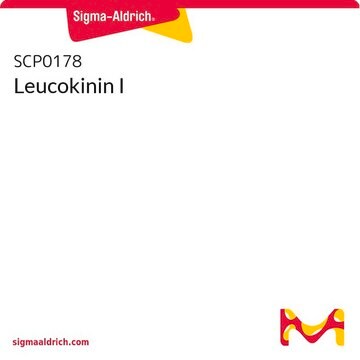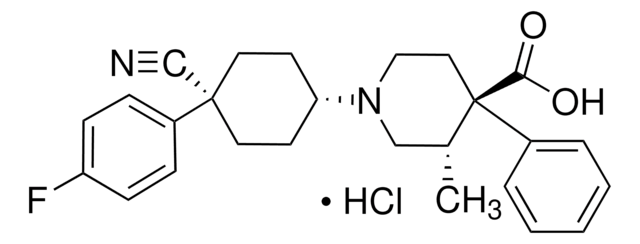About This Item
Wzór empiryczny (zapis Hilla):
C59H79N15O13
Masa cząsteczkowa:
1206.35
Kod UNSPSC:
12352209
NACRES:
NA.32
Polecane produkty
Próba
≥95% (HPLC)
Postać
lyophilized
skład
Peptide Content, ≥72%
warunki przechowywania
protect from light
temp. przechowywania
−20°C
Amino Acid Sequence
Glp-Phe-Trp-Ser-Tyr-Ala-Leu-Arg-Pro-Gly-NH2
Zastosowanie
Luteinizing-hormone-releasing hormone (LHRH) (GnRH) is a decapeptide (pyroQHWSYKLRPG-NH2) trophic hormone that regulates the release of follicle-stimulating hormone (FSH) and luteinizing hormone (LH) from the anterior pituitary. Various analogues have been developed using D-amino acids to increase resistance to degradation. These analogues are used as potential targeting agents in the development of chemotherapies and as possible agonists and antagonist of the LHRH receptor.
This page may contain text that has been machine translated.
Hasło ostrzegawcze
Danger
Zwroty wskazujące rodzaj zagrożenia
Zwroty wskazujące środki ostrożności
Klasyfikacja zagrożeń
Repr. 1B
Kod klasy składowania
6.1C - Combustible acute toxic Cat.3 / toxic compounds or compounds which causing chronic effects
Klasa zagrożenia wodnego (WGK)
WGK 3
Temperatura zapłonu (°F)
Not applicable
Temperatura zapłonu (°C)
Not applicable
Certyfikaty analizy (CoA)
Poszukaj Certyfikaty analizy (CoA), wpisując numer partii/serii produktów. Numery serii i partii można znaleźć na etykiecie produktu po słowach „seria” lub „partia”.
Masz już ten produkt?
Dokumenty związane z niedawno zakupionymi produktami zostały zamieszczone w Bibliotece dokumentów.
G Emons et al.
European journal of cancer & clinical oncology, 25(2), 215-221 (1989-02-01)
As a first step to investigate whether gonadotropin releasing hormone (GnRH) analogs might be able to modulate directly the proliferation of human epithelial ovarian carcinomata, we checked if binding sites for GnRH are present in these malignancies. Specific binding of
P J Wormald et al.
The Journal of clinical endocrinology and metabolism, 61(6), 1190-1194 (1985-12-01)
A specific, high affinity receptor for GnRH in human pituitaries obtained post mortem is described. The human pituitary GnRH receptor bound GnRH, a GnRH agonist [(D-Ala6,N alpha-MeLeu7,Pro9NEt)-GnRH], and a GnRH antagonist [Ac-D-Nal(2)1,D-alpha-Me-4-ClPhe2,D-3-Pal3,D-Arg6,D-Ala10 )-GnRH] with similar affinities (KdS of 4.81 nM
Andreas R Günthert et al.
Breast cancer research and treatment, 87(3), 255-264 (2004-11-06)
More than 50% of human breast cancers express receptors for luteinizing hormone-releasing hormone (LHRH-R). These receptors can be used for targeted chemotherapy with agents like AN-152, in which doxorubicin is linked to analog [D-Lys6]LHRH. We compared the effects of AN-152
Ana M Bajo et al.
Clinical cancer research : an official journal of the American Association for Cancer Research, 9(10 Pt 1), 3742-3748 (2003-09-25)
The receptors for luteinizing hormone-releasing hormone receptor (LHRH-R) are found in >50% of human breast cancers. Doxorubicin (DOX) was linked to [D-Lys(6)]LHRH to form a cytotoxic conjugate, AN-152, which can be targeted to tumor cells expressing LHRH-R. We evaluated the
Alexandra P Kafka et al.
Biomedical chromatography : BMC, 24(2), 132-139 (2009-06-12)
A high-performance liquid chromatography (HPLC) method for assay of d-Lys(6)-GnRH contained in a microemulsion-type formulation is described. The peptide is extracted from the microemulsion matrix and quantified using a two-step gradient method. Separation from microemulsion compounds and potential peptide oxidation
Nasz zespół naukowców ma doświadczenie we wszystkich obszarach badań, w tym w naukach przyrodniczych, materiałoznawstwie, syntezie chemicznej, chromatografii, analityce i wielu innych dziedzinach.
Skontaktuj się z zespołem ds. pomocy technicznej





